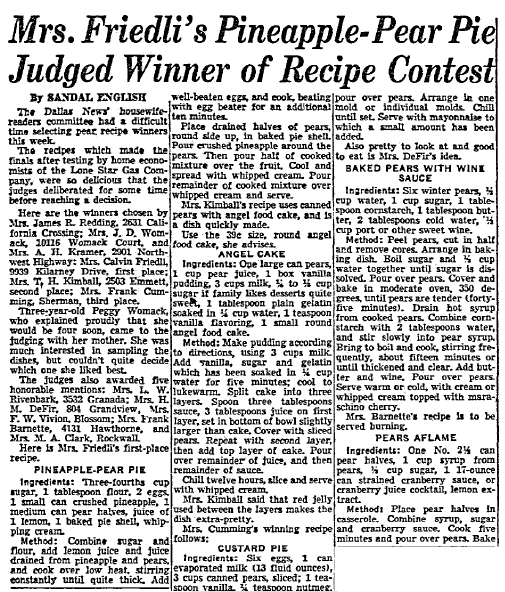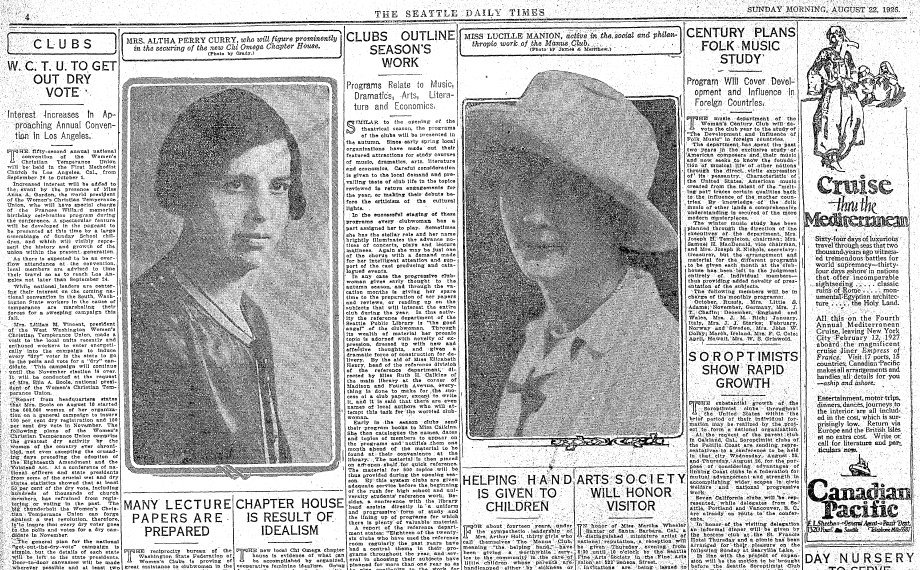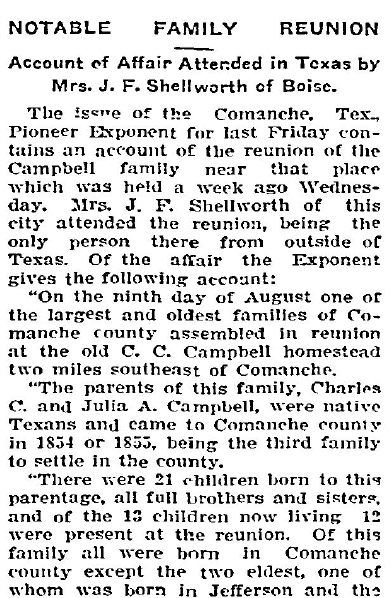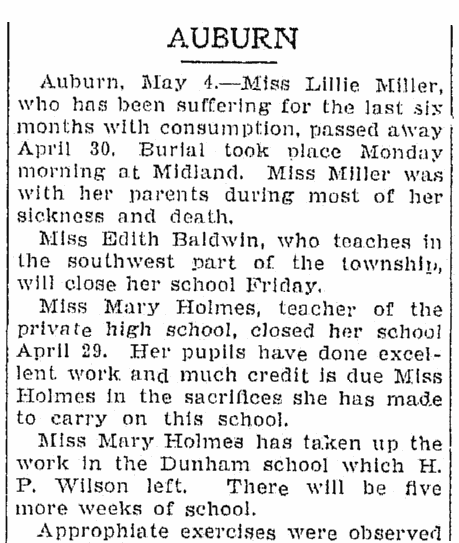Introduction: Gena Philibert-Ortega is a genealogist and author of the book “From the Family Kitchen.” In this blog article, Gena provides search tips to find your often-elusive female ancestors in old newspapers.
How do you find stories about your mother, grandmother, great-grandmother and other female ancestors in the newspaper? Sometimes that can be easier said than done, but here are a few tips to help you search for those elusive female ancestors.
What Types of News Articles Feature Women?
While the digitization of newspapers provides us the luxury of finding newspaper articles we weren’t specifically looking for, knowing what type of articles feature women can make it easier to focus your searches. It’s hard to imagine all the different types of articles a mother could be mentioned in, but reading copies of your ancestor’s local newspaper can be helpful. A few types of news articles to consider include the following.
Food & Recipe Newspaper Articles
What’s the best thing your mom cooks? Do you have memories of grandma’s homemade pies at Thanksgiving? Don’t forget that she could have been featured in the pages of the food section of the newspaper for her culinary prowess. Recipe contests sponsored by the newspaper or food companies, requests for recipes, or sharing a favorite recipe were all occasions for women to be published in the local newspaper.
For example, this article from a 1951 Texas newspaper about a pear recipe contest includes the names and addresses of the female judges and the winners. Even three-year-old Peggy Womack, who accompanied her mother to judge the entries, is mentioned.

Genealogy Tip: Remember that women may be mentioned using their husband’s name so don’t forget to try searching for her as Mrs. John Smith or Mrs. J. A. Smith.
Women’s Interest Pages
Women’s Interest pages printed all types of articles about women’s activities including causes they supported and clubs they were a member of. You can find mentions of events and articles that report on meetings at members’ homes, complete with an address.
Such is the case on this Clubs page from a 1926 Washington newspaper, which includes mentions of the WCTU (Women’s Christian Temperance Union), sororities, fraternal auxiliaries like Order of the Eastern Star, and Soroptimists. Awards women won, their names, addresses and even two photos can be found on this page.

Our female ancestors enjoyed club activities and membership in varied organizations. Identify membership organizations in the area your ancestor lived that she may have been a member of. Remember that she could have belonged to a group that believed in a cause she was passionate about (WCTU or League of Women Voters), was part of her church (Dorcas Society or Relief Society), or an auxiliary to an organization where her husband was a member (Women’s Relief Corp, Order of the Eastern Star).
There’s no doubt that being a mom and wife could get you in the paper as well. Whether it was for the birth of a baby, celebrating a wedding anniversary, attending a family reunion or even traveling with a child, your ancestress could be mentioned.
Great information about one family can be found in this report in a 1905 Idaho newspaper of the reunion attended in Texas by Mrs. J. F. Shellworth of Boise, Idaho. There are many names and much descendant information presented in this old newspaper article.

I have to admit my favorite part is the last paragraph that states:
Of this large family there is nor has been no stain on their moral characters, nor have any of them been arraigned before a court of justice as far back as the family history records.

Gossip & Social Columns
Don’t forget that gossip, social or “around town” articles provide opportunities for piecing together your female ancestor’s life. These short mentions often tell of the everyday activities she participated in like going shopping, traveling or even becoming ill.
For example, in this section of a 1904 Michigan newspaper entitled “News of Michigan Towns,” women are listed partaking in such activities as attending funerals, moving, attending club meetings, teaching, entertaining and in one instance passing away from a lengthy battle with consumption (TB):
Auburn, May 4.—Miss Lillie Miller, who has been suffering for the last six months with consumption, passed away April 30. Burial took place Monday morning at Midland. Miss Miller was with her parents during most of her sickness and death.

It’s All in the Name
I have discovered that often when I wasn’t able to find something in a digitized newspaper it was because I wasn’t searching my ancestor’s name the way the newspaper printed it. It’s always when I think the name can’t possibly be printed as Miss Philibert or M. B. Philibert that I’m proven wrong.
Genealogy Tip: Create a list of variations of your ancestor’s name and then add various spellings and misspellings to that list.
Keep a list of those name variations handy, and on that list have two parts. In the first part, write out all the variations of the name she could have used throughout her life. Such a list for one of my paternal great-grandmothers looks like this:
- Mary Bell Chatham
- Mary Chatham
- M.B. Chatham
- Miss Chatham
- Mary Bell Philibert
- Mary Philibert
- Mrs. Oscar Philibert
- Mrs. O. J. Philibert
Now if I add all the creative ways Chatham and/or Philibert can be spelled, my list starts to look like this:
- Mary Bell Chatham
- Mary Chatham
- M.B. Chatham
- Miss Chatham
- Mary Bell Philibert
- Mary Philibert
- Mrs. Oscar Philibert
- Mrs. O. J. Philibert
- Philbert
- Philabert
- Filabert
- Philburt
- Phillabert
So you get the idea of how many variations you may amass. Not sure how a name could possibly be misspelled? Ask a first or second grader. They will sound out the name and base their guess on phonetics, something that others may have done when spelling your ancestor’s name.
Before you give up on a genealogy search, always try another variation of your ancestor’s name.
Keep Track of Your Family History Research
As you research, keep a timeline of your female ancestor’s life so that you can determine what types of newspaper articles you might find during various times of her life, such as birth notices when she could be having children, or notices about her death. Along with that keep a research log and track your findings each time you research her in the newspaper. You will find a link to a free research log at the end of this article.
Because GenealogyBank is constantly adding new newspapers, you will need to conduct your search at least every month to find new results.
It’s no secret that I love the information that historical newspapers provide about our female ancestors. Finding mom (or grandma or great-grandma) is made easier when you know how to search. Honor your foremothers this week for Mother’s Day by locating stories about their lives in the newspaper.
Happy Mother’s Day!
Free Research Log Template
Not sure what a Research Log is or how to start one? No problem; with this free download from GenealogyBank you’ll be tracking your research in no time.
Clicking on the link (or the graphic) will let you download the Research Log template as a full-size, working Excel spreadsheet that you can use to organize and track your genealogy research. This log is compliments of Duncan Kuehn, who provided the following instructions:
Crafting your genealogy research plan:
- Title: Give your document a title. This will likely be the name of the person or family line that you are working on.
- Objective: Craft a very specific research objective. The more specific you can be the more effective your search will be. An example of a poorly crafted object would be: “Continue the Johnson line.” A better objective would be: “Find out when Jacob Johnson was born.” An even better objective would be: “Find out when Jacob Johnson (probable son of James Johnson and Sally Kunz) was born (likely 1882-1885 in Hardin County, Kentucky or Randolph County, South Carolina).” Having a clear objective keeps your search focused. Having more information helps you narrow your search and determine if you have found the right information.
- Date: Always enter a date for each entry. This will help you keep organized.
- Goal:Follow this basic outline for setting goals. Each goal or search should occupy its own row in the research plan.
- Confirm the known information.
- Identify which sources might contain more information. Prioritize these by likelihood to contain the information, reliability, ease of accessibility, quality, etc.
- Determine what possible documents might exist. For example, were birth certificates issued in the area at that time?
- Try to find the document.
- Check to see if any online resources have digitized the collection.
- If not, check to see if an online index exists.
- Check to see if any online resources have digitized the collection.
- Check to see if any near-to-you repositories have the collection.
- Check to see if any archives in the local jurisdiction have the collection.
- Obtain the document and analyze the information.
- Re-evaluate if the objective was met or not. If it was, then create a new research plan with a new objective. If not, determine what additional information is required and then identify which sources might contain that additional information.
- Source: Write down what source you are using to find the information. For example, when confirming the information where did you look? Was it on your family tree? Did you locate the birth certificate in your possession? Write down this source and include as much information as possible. Who authored it? What page in the book was it found on? What was the call number of the book? What was the URL of the online document?
- Repository: Write down where you found the source. Where was the document found? Was it in your possession? Did you locate it on FamilySearch? Was it in the local library? Write down as much information as you can here. If it is a place you intend to visit, be sure to include the address, phone number, website, etc.
- Result: Write down what you searched for and what you found. Be very, very specific. For example: “I searched for Jacob Aman’s (born 1901 in South Dakota) birth certificate on Ancestry, but nothing was found. I also used the spellings of Amman, Amann, Ammann, Anan, Amam, Amon, etc. I searched the time span of 1898-1903. I did not restrict it to a particular county.” That way when you think of or discover additional alternative spellings, such as Jakob or the initials J.B., you know to go back and try searching with the new information. When you do find information, record it here.
- #: Use this column to record the document number, include a link to the document that is stored on your computer, or list the document name as saved on your computer or in your paper files. You will want to access the document again. How will you find it? Enter that information in this column. Note: be sure to obtain a copy for yourself; don’t rely on finding the document again online, because URLs change, collections get culled and removed from websites, websites go defunct, etc.
Note: What is the difference between a genealogy research log and a research plan? A genealogy research plan includes the log, keeping all the information together. This prepares you for conducting the research: what documents exist, where can they be found? A research log would generally not include the goals of confirming the information, identifying the sources, locating where the source can be found, but instead would focus on the actual document search within a repository. This hybrid combines the best of both worlds to keep all the information in one place. I’ve called it a research plan because genealogists tend to focus on the document search when they need to focus on the preparatory work. The title is intended to remind them to slow down, focus their research, start at the beginning and work their way through. Once the document containing the information is found, the work is not done. Each fact needs to be confirmed by multiple sources. The evidence from each source needs to be properly evaluated. Finally, a written statement needs to be crafted to “prove” the answer, taking into account any evidence that contradicts the genealogist’s conclusion. Once this statement, paragraph, or report has been written, you are ready to move on – keeping in mind that new sources and evidence will be found and that might cause you to go back and revise your previous conclusions.
———————-
Related Articles:
- Tracing Female Ancestors: The Mother of All Genealogy Research
- Find Your Female Ancestors This Women’s History Month
- 8 Genealogy Tips for Tracing Female Ancestry
- Angela Cavallo Saves Her Son’s Life with Her Supermom Strength
- Mother of the Year Awards in the News
- Anna Jarvis Worked Hard to Make Mother’s Day a National Holiday

